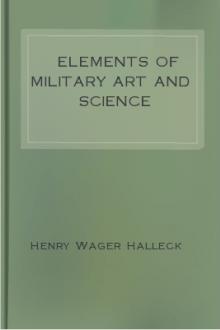Elements of Military Art and Science by Henry Wager Halleck (books you have to read txt) 📕

- Author: Henry Wager Halleck
- Performer: -
Book online «Elements of Military Art and Science by Henry Wager Halleck (books you have to read txt) 📕». Author Henry Wager Halleck
We now proceed to consider the circumstances attending the attack and defence of Copenhagen itself. The only side of the town exposed to the attack of heavy shipping is the northern, where there lies a shoal extending out a considerable distance, leaving only a very narrow approach to the heart of the city, (Fig. 35) On the most advanced part of this shoal are the Crown-batteries, carrying in all eighty-eight guns.[21] The entrance into the Baltic between Copenhagen and Salthorn, is divided into two channels by a bank, called the Middle Ground, which is situated directly opposite Copenhagen. To defend the entrance on the left of the Crown-batteries, they placed near the mouth of the channel four ships of the line, one frigate, and two sloops, carrying in all three hundred and fifty-eight guns. To secure the port and city from bombardment from the King's Channel, (that between the Middle Ground and town,) a line of floating defences were moored near the edge of the shoal, and manned principally by volunteers. This line consisted of old hulls of vessels, block-ships, prames, rafts, &c., carrying in all six hundred and twenty-eight guns—a force strong enough to prevent the approach of bomb-vessels and gunboats, (the purpose for which it was intended,) but utterly incapable of contending with first-rate ships of war; but these the Danes thought would be deterred from approaching by the difficulties of navigation. These difficulties were certainly very great; and Nelson said, beforehand, that "the wind which might carry him in would most probably not bring out a crippled ship." Had the Danes supposed it possible for Nelson to approach with his large vessels, the line of floating defences would have been formed nearer Copenhagen, the right supported by batteries raised on the isle of Amack. "In that case," says Napoleon, "it is probable that Nelson would have failed in his attack; for it would have been impossible for him to pass between the line and shore thus lined with cannon." As it was, the line was too extended for strength, and its right too far advanced to receive assistance from the battery of Amack. A part of the fleet remained as a reserve, under Admiral Parker, while the others, under Nelson, advanced to the King's Channel. This attacking force consisted of eight ships of the line and thirty-six smaller vessels, carrying in all eleven hundred guns, (without including those in the six gun-brigs, whose armament is not given.) One of the seventy-four-gun ships could not be brought into action, and two others grounded; but, Lord Nelson says, "although not in the situation assigned them, yet they were so placed as to be of great service." This force was concentrated upon a part of the Danish line of floating defences, the whole of which was not only inferior to it by three hundred and eighty-two guns, but so situated as to be beyond the reach of succor, and without a chance of escape. The result was what might have been expected. Every vessel of the right and centre of this outer Danish line was taken or destroyed, except one or two small ones, which cut and run under protection of the fortifications. The left of the line, being supported by the Crown-battery, remained unbroken. A division of frigates, in hopes of providing an adequate substitute for the ships intended to attack the batteries, ventured to engage them, but "it suffered considerable loss, and, in spite of all its efforts, was obliged to relinquish this enterprise, and sheer off."
[21]
Some writers say only sixty-eight or seventy; but the English writers generally say eighty-eight. A few, (apparently to increase the brilliancy of the victory,) make this number still greater.
The Danish vessels lying in the entrance of the channel which leads to the city, were not attacked, and took no material part in the contest. They are to be reckoned in the defence on the same grounds that the British ships of the reserve should be included in the attacking force. Nor was any use made of the guns on shore, for the enemy did not advance far enough to be within their range.
The Crown-battery was behind the Danish line, and mainly masked by it. A part only of its guns could be used in support of the left of this line, and in repelling the direct attacks of the frigates, which it did most effectually. But we now come to a new feature in this battle. As the Danish line of floating defences fell into the hands of the English, the range of the Crown-battery enlarged, and its power was felt. Nelson saw the danger to which his fleet was exposed, and, being at last convinced of the prudence of the admiral's signal for retreat, "made up his mind to weigh anchor and retire from the engagement." To retreat, however, from his present position, was exceedingly difficult and dangerous. He therefore determined to endeavor to effect an armistice, and dispatched the following letter to the prince-regent:
"Lord Nelson has directions to spare Denmark when no longer resisting; but if the firing is continued on the part of Denmark, Lord Nelson must be obliged to set on fire all the floating batteries he has taken, without the power to save the brave Danes who have defended them."
This produced an armistice, and hostilities had hardly ceased, when three of the English ships, including that in which Nelson himself was, struck upon the bank. "They were in the jaws of destruction, and would never have escaped if the batteries had continued their fire. They therefore owed their safety to this armistice." A convention was soon signed, by which every thing was left in statu quo, and the fleet of Admiral Parker allowed to proceed into the Baltic. Edward Baines, the able English historian of the wars of the French Revolution, in speaking of Nelson's request for an armistice, says: "This letter, which exhibited a happy union of policy and courage, was written at a moment when Lord Nelson perceived that, in consequence of the unfavorable state of the wind, the admiral was not likely to get up to aid the enterprise; that the principal batteries of the enemy, and the ships at the mouth of the harbor, were yet untouched; that two of his own division had grounded, and others were likely to share the same fate." Campbell says these batteries and ships "were still unconquered. Two of his [Nelson's] own vessels were grounded and exposed to a heavy fire; others, if the battle continued, might be exposed to a similar fate, while he found it would be scarcely practicable to bring off the prizes under the fire of the batteries."
With respect to the fortifications of the town, a chronicler of the times says they were of no service while the action lasted. "They began to fire when the enemy took possession of the abandoned ships, but it was at the same time the parley appeared." The Danish commander, speaking of the general contest between the two lines, says: "The Crown-battery did not come at all into action." An English writer says distinctly: "The works (fortifications) of Copenhagen were absolutely untouched at the close of the action." Colonel Mitchel, the English historian, says: "Lord Nelson never fired a shot at the town or fortifications of Copenhagen; he destroyed a line of block-ships, prames, and floating batteries that defended the sea approach to the town; and the Crown Prince, seeing his capital exposed, was willing to finish by armistice a war, the object of which was neither very popular nor well understood. What the result of the action between Copenhagen and the British fleet might ultimately have been, is therefore altogether uncertain. THE BOMBARDMENT OF COPENHAGEN BY NELSON, as it is generally styled, is therefore, like most other oracular phrases of the day, a mere combination of words, without the slightest meaning."
The British lost in killed and wounded nine hundred and forty-three men; and the loss of the Danes, according to their own account, which is confirmed by the French, was but very little higher. The English, however, say it amounted to sixteen or eighteen hundred; but let the loss be what it may, it was almost exclusively confined to the floating defences, and can in no way determine the relative accuracy of aim of the guns ashore and guns afloat.
The facts and testimony we have adduced, prove incontestably—
1st. That of the fleet of fifty-two sail and seventeen hundred guns sent by the English to the attack upon Copenhagen, two ships carrying one hundred and forty-eight guns were grounded or wrecked; seven ships of the line, and thirty-six smaller vessels, carrying over one thousand guns, were actually brought into the action; while the remainder were held as a reserve to act upon the first favorable opportunity.
2d. That the Danish line of floating defences, consisting mostly of hulls, sloops, rafts, &c., carried only six hundred and twenty-eight guns of all descriptions; that the fixed batteries supporting this line did not carry over eighty or ninety guns at most; and that both these land and floating batteries were mostly manned and the guns served by volunteers.
3d. That the fixed batteries in the system of defence were either so completely masked, or so far distant, as to be useless during the contest between the fleet and floating force.
4th. That the few guns of these batteries which were rendered available by the position of the floating defences, repelled, with little or no loss to themselves, and some injury to the enemy, a vastly superior force of frigates which attacked them.
5th. That the line of floating defences was conquered and mostly destroyed, while the fixed batteries were uninjured.
6th. That the fortifications of the city and of Amack island were not attacked, and had no part in the contest.
7th. That, as soon as the Crown-batteries were unmasked and began to act, Nelson prepared to retreat, but, on account of the difficulty of doing so, he opened a parley, threatening, with a cruelty unworthy of the most barbarous ages, that, unless the batteries ceased their fire upon his ships, he would burn all the floating defences with the Danish prisoners in his possession; and that this armistice was concluded just in time to save his own ships from destruction.
8th. That, consequently, the battle of Copenhagen cannot be regarded as a contest between ships and forts, or a triumph of ships over forts: that, so far as the guns on shore were engaged, they showed a vast superiority over those afloat—a superiority known and confessed by the English themselves.
Constantinople.—The channel of the Dardanelles is about twelve leagues long, three miles wide at its entrance, and about three-quarters of a mile at its narrowest point. Its principal defences are the outer and inner castles of Europe and Asia, and the castles of Sestos and Abydos. Constantinople stands about one hundred miles from its entrance into the Sea of Marmora, and at nearly the opposite extremity of this sea. The defences of the channel had been allowed to go to decay; but few guns were mounted, and the forts were but partially garrisoned. In Constantinople not a gun was mounted, and no preparations for defence were made; indeed, previous to the approach of the fleet, the Turks had not determined whether to side with the English or the French, and even then the French ambassador had the greatest difficulty in persuading them to resist the demands of Duckforth.
The British fleet consisted of six sail of the line, two frigates, two sloops, and several bomb-vessels, carrying eight hundred and eighteen guns, (besides those in the bomb-ships.) Admiral Duckforth sailed through the Dardanelles on the 19th of February, 1807, with little or no opposition. This being a Turkish festival day, the soldiers of the scanty garrison were enjoying





Comments (0)